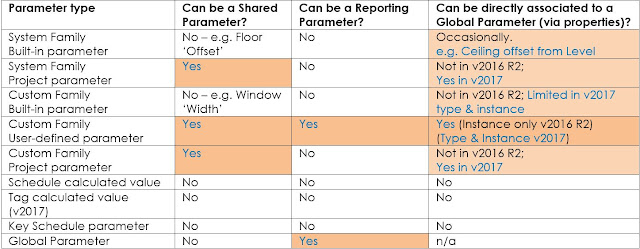I thought I would share some of my findings here, as they could be useful for reference generally - regardless of whether you are using Global parameters or not. I will be referring to some of this research in my presentation, but won't have time to go into detail as the main focus will be the exciting possibilities Global Parameters.
Understanding Different Kinds of Parameters in Revit
System Family built-in Parameters – these are properties that are hard-coded into Revit software, and can be used where available. They can usually be scheduled and sometimes tagged, but not always. They can apply as instance (&/or type) data to:
- system families: walls, floors, ceilings, stairs, railings etc
- Project info
- View and sheet parameters
- Areas, Rooms and Spaces
Custom family built-in parameters – system defined (type or instance)
Project Parameters – exist only in the project; user defined; have to be assigned to categories, and hence to families; and cannot include calculations
Shared Parameters – derived from an external master list; can be scheduled and tagged
- can be used for Family (custom) or project parameters, but not for Global or system/built-in parameters
Reporting Parameters – extract a length or angle from a model, for use in calculations within families or global parameters; have many limitations within custom families
Calculated Value - these are properties (not real parameters) created within a schedule or tag family (from Revit 2017) - they can include formulas or just be static values for use in other formulas or scheduling; they are not available anywhere else except the schedule or tag that they are created in.
Key Schedule Parameter - a special kind of schedule can be created that works like a lookup table; a very few built-in parameters can be included in a key schedule, in which case they are available for tagging; user created key schedule parameters cannot be Shared Parameters, which makes them of very limited usefulness. If this latter functionality could be fixed, then Key Schedules would become a very important part of Revit, instead of languishing in the backwaters of arcane uselessness.



Ive been looking at driving parameters using key schedules lately and quite shocked at the limitations.
ReplyDeleteIt could be so helpful for driving fire/acoustic/thermal properties for wall, window & door schedules.
Adsk need to allow shared parameters to be 'keyed' otherwise its practically useless.
Still not sure about global parameters.. jury is out.